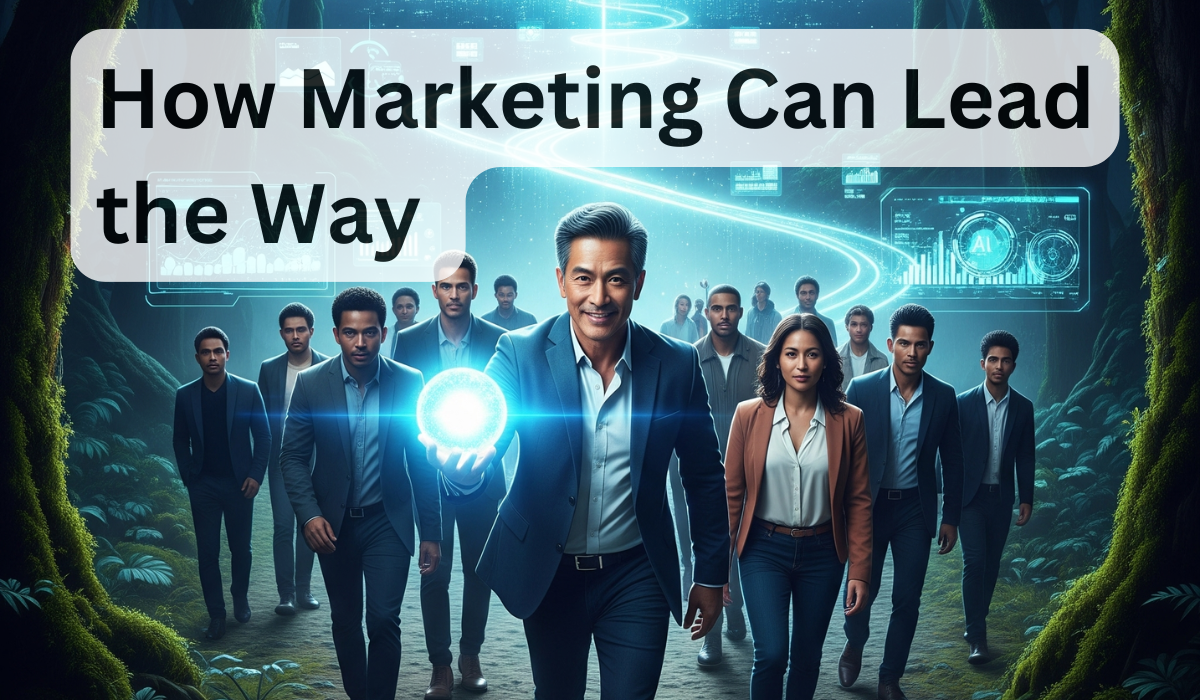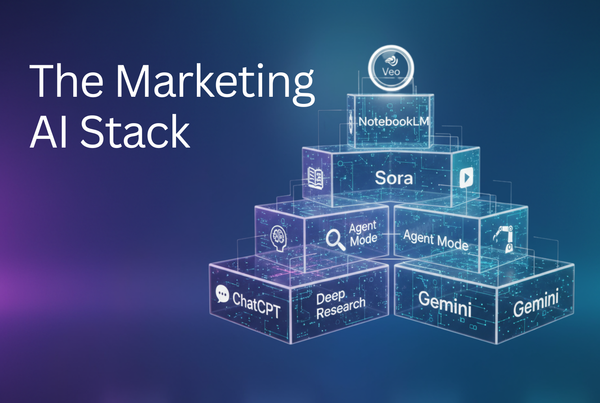How Marketing Leaders Can Accelerate Company-Wide AI Adoption
Turn your team’s AI momentum into a catalyst for organization-wide transformation

In many companies, AI adoption isn’t being driven by IT. It’s not coming from the top, either. It’s bubbling up from the bottom—quietly, creatively, and often in marketing.
Marketing teams were among the earliest adopters of digital media, automation, and data tools. Today, they’re again leading the way—experimenting with generative AI to write content, create ads, analyze campaigns, and more. But too often, those efforts remain siloed or under-recognized.
If you're a marketing leader, you have a powerful opportunity: to turn your team’s AI momentum into a catalyst for organization-wide transformation.
You’re Not Just Adopting AI—You’re Shaping the Culture That Will Use It
AI will change how businesses operate. But the change won’t come from a single tool or policy. It will come from how teams experiment, learn, and lead.
Marketing teams are already wired for this. Marketers are naturally curious, deadline-driven, and fluent in testing hypotheses. They're accustomed to optimizing outputs, measuring performance, and working with evolving tools, shifting platforms, and constant learning. These traits make them especially suited to shaping an AI-ready culture.
A new McKinsey article, The Learning Organization, outlines four mindsets that help organizations adopt AI faster and more effectively:
- Nurture what’s already growing (not just what’s planned)
- Reward learning, not just usage
- Design fast, purposeful experiments
- Praise selectively, celebrate insight—not hype
These ideas resonate deeply with the pace and style of how marketing teams already operate. With their strengths in data, experimentation, storytelling, and customer empathy, marketers are ideal culture carriers for AI innovation. Here are several ways 's how to apply these principles from the marketer’s seat.
1. Surface and Support AI “Sprouts” Across the Business
Marketers are often the first to explore emerging technologies—and AI is no exception. With their frontline exposure to tools, trends, and customer feedback, marketing teams are uniquely positioned to spot early AI use cases across the organization.
Use your team’s natural curiosity and observational mindset to surface grassroots innovation. Encourage your team to share their experiments, even the scrappy ones. Extend this mindset beyond your department by spotlighting smart experimentation happening in other functions.
What you can do:
- Invite team members to share “how I’m using AI” during a team huddle.
- Highlight internal wins—like how one marketer saved 3 hours a week automating reports.
- Build a shared “prompt library” or swipe file of effective AI use cases.
- Develop a company-wide AI use case gallery that documents experiments and outcomes across departments.
By celebrating what’s already happening and making it visible, marketers help transform isolated usage into shared learning—laying the groundwork for broader adoption.
2. Build a Culture of Learning and Experimentation
Marketers thrive in dynamic environments. They’re comfortable with ambiguity, skilled at learning on the fly, and used to peer-driven knowledge sharing. This mindset is essential to AI adoption—and marketing leaders can bring it to life across the business.
Use your team’s natural rhythm of experimentation to inspire a company-wide culture shift. Show that AI success isn’t about perfection—it’s about learning.
Ideas to implement:
- Host quarterly “AI Lab” days for exploration and experimentation.
- Launch an internal “AI Champions” group across departments.
- Give shout-outs not just for results, but for learning: “Best prompt of the week,” “Most unexpected insight,” etc.
- Create internal training materials, how-to videos, and onboarding guides tailored to company workflows.
- Organize internal AI showcases or “town halls” where teams can demo what they’ve tried and learned.
Marketing’s creative and communication strengths make it the perfect team to craft training experiences that are not only effective—but engaging and inspiring.
3. Lead Strategic, Cross-Functional Pilots
Marketing’s test-and-learn mindset, honed through years of testing, segmentation, and campaign optimization, makes it a natural leader for designing high-impact AI pilots.
Rather than waiting for top-down initiatives, marketing leaders can initiate AI experiments across departments. This approach not only demonstrates impact—it builds credibility and momentum.
Example pilots:
- Can AI-generated copy outperform human versions?
- Can AI cluster customer feedback faster than manual review?
- Can AI reduce HR onboarding time or improve internal reporting in finance?
Use marketing’s analytics acumen and speed of execution to create well-structured, time-boxed experiments. Share the results with clarity and humility—whether they succeed or fail—and encourage other teams to do the same.
4. Champion Cross-Functional Alignment and Vision
Marketing knows how to create alignment around a message—and that same skill can drive alignment around a vision for AI.
Marketing leaders can shape a shared strategy, not just for how AI tools are used, but for how they align with the company’s brand, customer promise, and operational goals. By bringing storytelling, insight, and cross-functional relationships to the table, marketers can help ensure that AI adoption has both purpose and direction.
What you can do:
- Propose and lead an AI steering committee with leaders from product, ops, HR, IT, and finance.
- Help co-create an AI roadmap and prioritize use cases based on real business needs.
- Translate technical concepts into compelling business narratives that resonate across teams.
This isn’t about control—it’s about influence. Marketing leaders can help others see themselves in the AI future and feel invited to shape it.
5. Set a Standard for Honest Innovation
Marketers understand the difference between a headline and a hard metric. They’ve lived through hype cycles before, and they know how to spot substance beneath the noise.
Use that instinct to build a culture of transparency. Elevate AI stories that are meaningful—not just flashy. Your team’s reputation for rigor and relevance will set the tone for how others talk about AI, too.
What you can do:
- Share real, measurable outcomes—“This automation reduced a task from 3 hours to 15 minutes.”
- Normalize failed experiments that yield insights—“This didn’t work, but now we know why.”
- Create internal case studies that highlight both the process and the result.
When marketers frame AI as a journey of discovery—not just disruption—they model the kind of learning environment that allows innovation to take root.
6. Model the Behavior You Want to See
Marketing leaders often lead by influence, not authority. That gives them a powerful platform to model the very behavior they want others to embrace.
Share what you're trying. Be honest about what’s confusing. Offer help where you can. These acts of vulnerability and generosity create psychological safety and encourage experimentation across the organization.
What you can do:
- Talk openly about the AI tools you’re testing—and what’s working.
- Admit where you’re still figuring things out.
- Show how workflows are changing so others can reconsider theirs.
- Help leadership shape a consistent internal narrative that celebrates how AI is helping realize the company's vision.
When marketers go first, they don’t just signal what’s possible. They create permission for others to follow.





